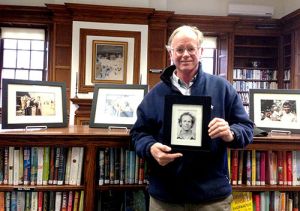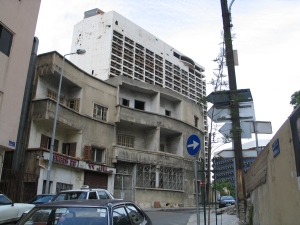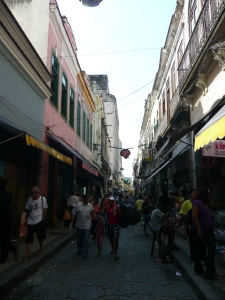by Loumarie I. Rodriguez | Posted: Wednesday, December 10, 2014 6:00 am
BRIDGEWATER — Since 1972, First Selectman Curtis Read‟s photos, documenting his trip around the globe were left untouched for 40 years.
He finally began to go through negatives and slides in 2012. The results are currently on exhibit at the Burnham Library.
From 1971 to 1972, Mr. Read went on a nine-month journey to various countries, photographing people and their daily lives.

Bridgewater First Selectman Curtis Read poses with his original passport photo.
Photo Credit- Rodriguez
Mr. Read considered himself to be a serious photographer at the time. He graduated from Hamilton College with a degree in photography and film. During his adventure, Mr. Read saw history in the making, including seeing a glimpse of Fidel Castro who wasvisiting Chile at the same time as Mr. Read.
He also saw the refugees that flocked into Kolkata, India, during the Bangladesh Liberation War.
Mr. Read documented his journey from country to country through photos and some journal entries. The exhibit at the Burnham Library displays 35 of his photographs.
Half of the photos were shot with colored filters; the other half are in black and white with a focus on people rather than landscapes. Mr. Read referred to the 35mm photos as a time capsule because of the old form they were taken in.
“You couldn‟t burn a lot of pictures,” said Mr. Read. “I was carrying a lot of stuff and I didn‟t want to have 50 rolls of film in the bottom of my backpack trekking through mountains.”
His journey began with a flight out of John F. Kennedy Airport with a friend who accompanied Mr. Read for five months of the trip.
Mr. Read said the trip was more about photography and not about getting wild.
“There were people on the road then that were going around the world to pleasure themselves with drugs and whatever,” said Mr. Read. “That was
definitely going on in the early „70s and late „60s.”
Mr. Read had purchased an around-the-world plane ticket and set out to fulfill what he described as his “wanderlust.”
He began in South America. While in Chile, which was experiencing political turmoil at the time, he and many other American travelers were placed under house arrest because of a visit from Fidel Castro, the former leader of the Cuban communist party.
“They rounded up all the Americans they could find and said we were either spies or potential spies and they took away our cameras,” said Mr. Read. “They left us in the hotel.”
He said his hotel was in southern Chile on a main street with guards outside the doors. While leaning out the balcony on his second floor hotel room, Mr. Read saw both Castro and former Chilean President Salvador Allende in front of his hotel. Allende was assassinated a year after Mr. Read‟s trip. During the trip, Mr. Read and his friend picked up odd jobs. In Rio de Janeiro, Mr. Read taught photography classes. He also worked as sound person for a film and was a bodyguard for a Brazilian businessman while in Brazil.
He bought opals in Australia and sold them in Singapore and even free- lanced a few of his photographs for a German magazine.
He said he did odd jobs to make just enough money to get by while on his trip.
The few problems Mr. Read faced while on his journey were the Indo- Pakistani war of 1971. Rather than go through Pakistan to his next destination, Mr. Read had to fly over the country.
He had wanted to do Asia by land, which is considered to be hard traveling, according to Mr. Read because there is the possibility of traveling with animals on board your vehicle. Many of the countries Mr. Read passed through were third world countries as well.
Another difficulty he faced was traveling from Afghanistan to Turkey because the people were not friendly.
Mr. Read said many of the people were suspicious of Americans since they were perceived as meddlers.
“There was also a civil war in Beirut, Lebanon,” said Mr. Read. “There was a lot of civil unrest and you had to be careful.
“South America was also dangerous in a few places. We weren‟t that welcomed in Chile and Uruguay had terrible inflation. Argentina had unrest and gunfire. We saw tanks in the night.”
In La Paz, Bolivia, there was a revolution and a bombing at the university. He called a lot of the unrest potentially dangerous situations.
Another major difficulty he faced was the physical demand of traveling. There was always the possibility of getting sick or eating bad food or drinking bad water with no way of taking care of oneself in certain countries.
While in Nepal, Mr. Read had accidently consumed bad water. A Peace Corp volunteer assisted Mr. Read and gave him medicine. Despite becoming very ill, he said one of his favorite destinations was Nepal.
“As far as physical beauty to see and I walked between the fourth and seventh highest mountain in the world, it [Nepal] was astounding,” said Mr. Read.
“The culture is amazing. There are no roads and everybody carries everything. They carry a lot more weight than we carry.”
Other destinations that thoroughly astounded him were Machu Picchu in Peru, the Andes, New Zealand and the Iguazu Falls, which border Argentina and Brazil.
On his journey Mr. Read managed to visit every capital in South America; he stayed the longest in Rio de Janeiro.
He visited so many countries that he had to stop at an American embassy to get more pages in his passport.
Mr. Read took photos of scenery, landscapes but mainly of people. He also wrote journal entries of travels. Excerpts of his journal will be posted next to his photographs at the exhibit.
According to Mr. Read he barely took any photos in Kolkata because many of the refugees were dying in the streets.
“You didn‟t feel too good if you were a traveler,” said Mr. Read. “I didn‟t take any pictures of that. I couldn‟t.”
When he arrived back in the U.S. nine months later Mr. Read went straight to work and didn‟t have the time or the resources to develop his photos. Finally in 2012 he pulled out his negatives and slides and began to remove spots and dust off the film.
“It was a time capsule that I felt was time to get out of the box and see what is really there,” said Mr. Read.
The exhibit “Photographs of World Travel” is on display in the Burnham Library into January.


